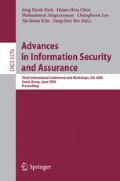Abstract
This paper proposes a novel approach based on the honeybee model to improve the intrusion detection system. The power of defending the intruder from entering the hive, the effectiveness of exchanging information between the bees and the successfulness of other existing AI approaches that honey bee can be efficiently compared to, have lead us towards analyzing a new area in honeybee concerning security. Most existing systems only detect general and known attacks. Therefore a lot of malicious attacks intrude without any detection. We demonstrate the methods that use HoneybeeGuard in filtration and classification; “undesirable–absent” and “desirable–present”, to identify a malicious packet, and detect the known and unknown intruders.
Access this chapter
Tax calculation will be finalised at checkout
Purchases are for personal use only
Preview
Unable to display preview. Download preview PDF.
References
Vinod, Y., Paul, B., Johannes, U.: Internet intrusions: global characteristics and prevalence. In: International conference on measurement and modeling of computer systems, USA (2003)
Liu, P.: Architectures for intrusion tolerant database systems. In: Annual, P.t. (ed.) Computer Security Applications Conference (2002)
Gu Hsin, L., Chia-Mei, C., Bing-Chiang, J., Willams, C.: Ant-based IP traceback, vol. 34, pp. 3071–3080. Pergamon Press, Inc., Oxford (2008), http://dx.doi.org/3010.1016/j.eswa.2007.3006.3034
Mukkamala, S., Janowski, G., Sung, A.: Intrusion detection using neural networks and support vector machines. In: Janoski, G. (ed.) Neural Networks, vol. 2 (2002)
Couvillon, M.J., Robinson, E.J.H., Atkinson, B., Child, L., Dent, K.R., Ratnieks, F.L.W.: En garde: rapid shifts in honeybee, Apis mellifera, guarding behaviour are triggered by onslaught of conspecific intruders. Animal Behaviour 76, 1653–1658 (2008)
Horridge, G.A.: Pattern discrimination by the honeybee (Apis mellifera): training on two pairs of patterns alternately. Journal of Insect Physiology 45, 349–355 (1999)
Breed, D., Guzmán-Novoa, E., Hunt, G.J.: Defensive behavior of honey bees:organization, genetics, and comparisons with other Bees. Annual Review of Entomology 49, 271–298 (2004)
Butler, C.G., Free, J.: The behaviour of worker honeybees at the hive entrance. Behaviour 4, 263–291 (1952)
Vincent, J., Mintram, R., Phalp, K., Anyakoha, C., Bauerdick, H., Gottfried, B., Muthuraman, S.: AI Solutions for MDS: Artificial Intelligence Techniques for Misuse Detection and Localisation in Telecommunications Environments (July 2006), http://www.comarch.com/en/MDS
Charles, P.P., Shari Lawrence, P.: Security in Computing. Prentice Hall Professional Technical Reference (2002)
Simson, G., Gene, S.: Practical Unix and Internet security, 2nd edn. O’Reilly & Associates, Inc., Sebastopol (1996)
Hofmeyr, S.A.: An Immunological Model of Distributed Detection and its Application to Computer Security. Vol. PhD thesis. University of New Mexico (1999)
Kitching, I.J.: Phylogeny of the death’s head hawkmoths, Acherontia[Laspeyres], and related genera (Lepidoptera: Sphingidae: Sphinginae: Acherontiini. Systematic Entomology (2003)
Ratnieks, M.J.C.F.L.W.: Odour transfer in stingless bee marmelada (Frieseomelitta varia) demonstrates that entrance guards use an “undesirable–absent” recognition system. Behav. Ecol. Sociobiol. 62, 1099–1105 (2008)
Sherman, P.W., Reeve, H., Pfennig, D.: Recognition systems. In: Krebs, J.R., Davies, N.B. (eds.) Behavioural Ecology, pp. 69–96. Blackwell Science, Oxford (1997)
Lacy, R.C., Sherman, P.: Kin recognition by phenotype matching. Am. Nat. 116, 489–512 (1983)
Ratnieks, F.L.W., Downs, S.G.: Adaptive shifts in honey bee (Apis mellifera) guarding behavior support predictions of the acceptance threshold model. Behavioral Ecology 11 (2000)
Author information
Authors and Affiliations
Editor information
Editors and Affiliations
Rights and permissions
Copyright information
© 2009 Springer-Verlag Berlin Heidelberg
About this paper
Cite this paper
Ali, G.A., Jantan, A., Ali, A. (2009). Honeybee-Based Model to Detect Intrusion. In: Park, J.H., Chen, HH., Atiquzzaman, M., Lee, C., Kim, Th., Yeo, SS. (eds) Advances in Information Security and Assurance. ISA 2009. Lecture Notes in Computer Science, vol 5576. Springer, Berlin, Heidelberg. https://doi.org/10.1007/978-3-642-02617-1_61
Download citation
DOI: https://doi.org/10.1007/978-3-642-02617-1_61
Publisher Name: Springer, Berlin, Heidelberg
Print ISBN: 978-3-642-02616-4
Online ISBN: 978-3-642-02617-1
eBook Packages: Computer ScienceComputer Science (R0)

